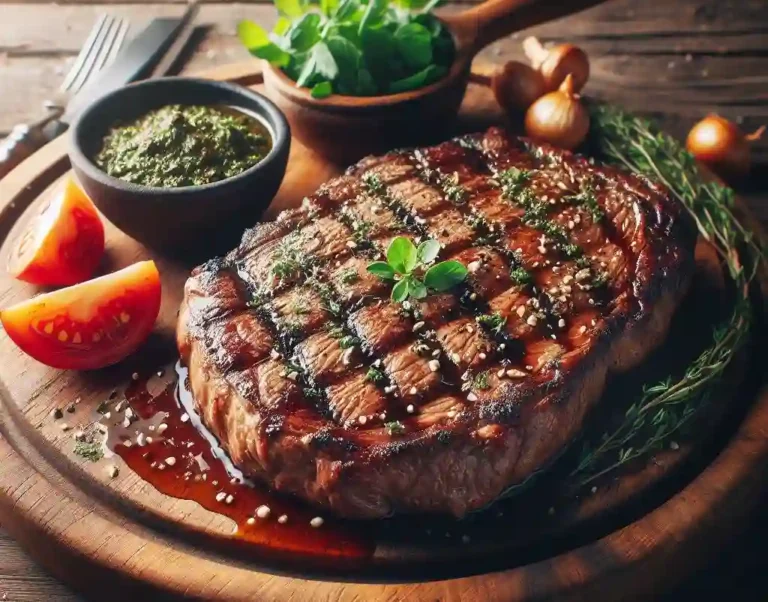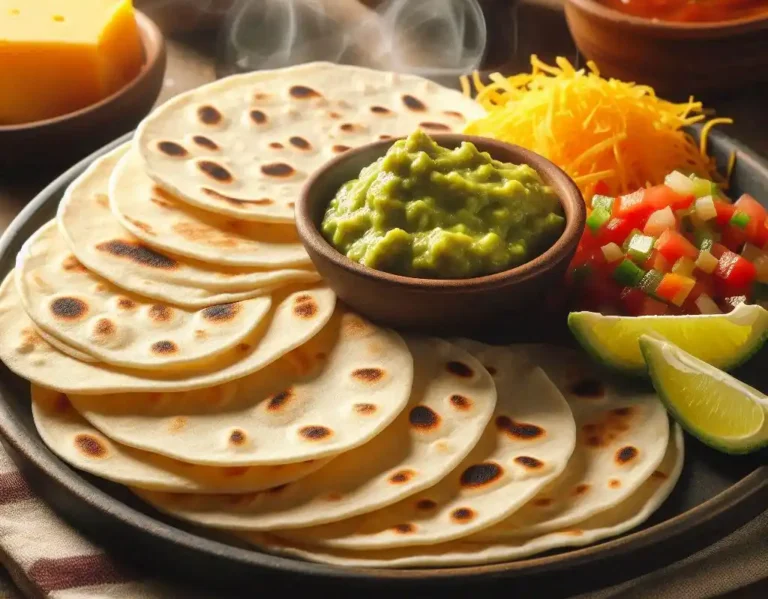How to Make Taco Meat Like Mexican Restaurants? – Authentic Flavor
Taco meat is a staple of Mexican cuisine, and when done right, it’s a flavor explosion that’s hard to resist.
It’s not just about throwing some ground beef and spices into a pan; it’s about understanding the nuances of traditional Mexican cooking and the techniques that bring out the rich, depthful flavors we’ve come to associate with this beloved dish.
How to Make Taco Meat Like Mexican Restaurants? – A Quick Overview

- Choose the Right Ground Beef
- Use 80/20 or 70/30 ground beef for optimal flavor and texture
- Avoid lean ground beef for a more authentic flavor
- Master the Browning Process
- Brown the ground beef in small batches for even cooking
- Use a hot skillet and a small amount of oil for a rich, caramelized crust
- Add Aromatics for Depth of Flavor
- Sauté onions, garlic, and jalapeños for added flavor and aroma
- Use fresh cilantro for an authentic Mexican flavor
- Balance the Flavors
- Use a blend of spices, including cumin, chili powder, and paprika
- Add a splash of acidity with lime juice or vinegar
- Add Moisture and Body
- Use diced tomatoes for added moisture and flavor
- Add a small amount of tomato paste for depth of flavor
- Season and Simmer
- Season the taco meat with salt, pepper, and any other desired spices
- Simmer the mixture for at least 30 minutes to allow the flavors to meld together
The Secret to Rich Flavor: Choosing the Right Ground Beef

Understanding Ground Beef Options:
- 80/20: 80% lean beef, 20% fat. This is a good all-purpose choice for taco meat, offering a balance of flavor and moisture.
- 70/30: 70% lean beef, 30% fat. This option is ideal for those who want a richer, more indulgent flavor.
- 90/10: 90% lean beef, 10% fat. This is a good choice for those who want a leaner taco meat, but may lack richness and flavor.
What to Look for in Ground Beef:
- Grass-fed vs. Grain-fed: Grass-fed beef tends to be leaner and have a more robust flavor, while grain-fed beef is often richer and more marbled.
- Wagyu vs. Angus: Wagyu beef is known for its intense marbling and rich flavor, while Angus beef is often leaner and more affordable.
- Local vs. Imported: Consider choosing locally sourced ground beef for a more authentic flavor and to support local farmers.
Tips for Choosing the Right Ground Beef:
- Avoid overly lean ground beef, as it can result in dry, flavorless taco meat.
- Opt for a mix of chuck, brisket, or short rib for a more complex flavor profile.
- Consider grinding your own beef for the ultimate control over fat content and flavor.
- Don’t overwork the meat when mixing and cooking, as this can lead to tough, dense taco meat.
The Magic of Mexican Spices: Unlocking Authentic Flavor

The Essential Spices:
- Cumin: adds warmth, depth, and a hint of earthiness
- Chili powder: provides a rich, slightly sweet, and smoky flavor
- Paprika: adds a subtle sweetness and a pop of color
- Garlic powder: enhances flavor and aroma
- Onion powder: adds a savory, slightly sweet flavor
- Oregano: provides a pungent, earthy flavor
The Magic of Blending:
- Customize your blend: experiment with different ratios of spices to create your signature flavor
- Balance is key: aim for a harmonious balance of flavors, rather than overpowering the dish
- Layer your flavors: add spices at different stages of cooking to build depth and complexity
Unlocking Authentic Flavor:
- Use high-quality spices: fresh, aromatic spices make a huge difference in flavor
- Toast your spices: lightly toasting spices brings out their natural oils and enhances flavor
- Experiment with different chili peppers: ancho, guajillo, and habanero peppers each offer unique flavor profiles
- Add a pinch of acidity: a squeeze of lime juice or a splash of vinegar can brighten and balance flavors
Tips and Variations:
- Add a smoky flavor: use chipotle peppers or smoked paprika for a smoky, BBQ-like flavor
- Go bold with spices: add a pinch of cayenne or diced jalapeños for an extra kick
- Try different spice blends: experiment with blends like adobo, fajita, or mole for unique flavor profiles
- Make it your own: don’t be afraid to experiment and adjust spice levels to your taste
Brown It Like a Pro: The Importance of Proper Browning

Why Browning Matters:
- Flavor development: browning creates a rich, caramelized crust on the meat, enhancing flavor and aroma
- Texture improvement: browning helps to break down connective tissues, making the meat more tender and juicy
- Visual appeal: a nicely browned dish is more appetizing and visually appealing
The Science of Browning:
- Maillard Reaction: a chemical reaction between amino acids and reducing sugars that occurs when food is cooked, leading to the formation of new flavor compounds and browning
- Caramelization: the process of sugars breaking down and reforming into new compounds, creating a rich, sweet flavor
Tips for Proper Browning:
- Use the right pan: choose a pan that can withstand high heat, such as stainless steel or cast iron
- Preheat the pan: heat the pan before adding oil and meat to ensure even browning
- Use the right oil: choose an oil with a high smoke point, such as avocado or grapeseed oil, to prevent burning
- Don’t overcrowd: cook in batches if necessary, to ensure each piece of meat has enough room to brown evenly
- Don’t stir too much: let the meat develop a nice crust on the bottom before stirring or flipping
- Use a thermometer: monitor the pan temperature to ensure it reaches the optimal browning range (325°F – 375°F)
Common Mistakes to Avoid:
- Insufficient heat: not heating the pan enough, leading to pale, steamed meat
- Overcrowding: cooking too much meat at once, preventing even browning
- Stirring too much: constantly stirring the meat, preventing the formation of a nice crust
- Not letting it rest: not letting the meat rest after browning, leading to a tough, dry texture
The Role of Aromatics: Onions, Garlic, and Beyond

The Power of Aromatics:
- Flavor enhancement: aromatics add depth, complexity, and richness to dishes
- Aroma enhancement: aromatics release volatile compounds that stimulate the sense of smell and enhance the overall aroma of a dish
- Texture contrast: aromatics can add a satisfying crunch or softness to dishes
Onions: The Foundation of Flavor
- Caramelization: cooking onions slowly to bring out their natural sugars and enhance flavor
- Sweetness and depth: cooked onions add a sweet, savory flavor to dishes
- Texture variety: onions can be cooked to a range of textures, from crunchy to soft and caramelized
Garlic: The Flavor Amplifier
- Pungency and depth: garlic adds a pungent flavor that enhances the overall flavor profile of a dish
- Aroma enhancement: garlic releases aromatic compounds that stimulate the sense of smell
- Variety of preparations: garlic can be cooked in a range of ways, from roasted to sautéed to raw
Beyond Onions and Garlic:
- Shallots and scallions: add a sweet, oniony flavor and crunchy texture
- Leeks: mild, sweet flavor and a soft, tender texture
- Mushrooms: earthy flavor and meaty texture
- Celery: fresh, green flavor and crunchy texture
- Herbs: fresh or dried, herbs add bright, fresh flavors to dishes
Tips for Working with Aromatics:
- Choose the right variety: select the right type of onion, garlic, or other aromatic for the dish
- Prepare them properly: chop, slice, or mince aromatics to release their flavors and textures
- Cook them correctly: sauté, roast, or caramelize aromatics to bring out their natural flavors
- Balance flavors: combine aromatics with other ingredients to create a balanced flavor profile
The Power of Acidity: How Tomatoes and Lime Juice Elevate Flavor

The Role of Acidity:
- Balances flavors: acidity cuts through richness and balances flavors in a dish
- Enhances flavors: acidity brings out the natural flavors of ingredients and adds brightness to a dish
- Adds depth: acidity adds a layer of complexity and depth to a dish
Tomatoes: The Acidic Powerhouse
- Natural acidity: tomatoes have a natural acidity that enhances flavors and balances richness
- Flavor enhancement: tomatoes add a burst of juicy flavor to dishes
- Texture variety: tomatoes can be used in a range of textures, from fresh and crunchy to cooked and soft
Lime Juice: The Brightening Agent
- Citrusy zing: lime juice adds a bright, citrusy flavor to dishes
- Balances richness: lime juice cuts through richness and balances flavors in a dish
- Enhances aromas: lime juice enhances the aromas of other ingredients in a dish
Tips for Using Acidity:
- Use tomatoes in a variety of forms: use fresh, canned, or cooked tomatoes to add acidity and flavor to dishes
- Add lime juice at the right time: add lime juice towards the end of cooking to preserve its bright, citrusy flavor
- Balance acidity with richness: balance the acidity of tomatoes and lime juice with rich ingredients like meats and cheeses
- Experiment with different acidic ingredients: try using other acidic ingredients like vinegar, citrus, or yogurt to add brightness and depth to dishes
The Perfect Balance: Combining Flavors for Authentic Taco Meat

The Flavor Profile:
- Savory: beef or alternative protein provides a rich, savory flavor
- Spicy: chili peppers or hot sauce add a spicy kick
- Smoky: cumin, chili powder, and smoked paprika add a smoky depth
- Bright: lime juice or vinegar adds a bright, acidic flavor
- Umami: tomatoes or tomato paste add a rich, savory flavor
Balancing Flavors:
- Start with a base flavor: use beef or alternative protein as the base flavor
- Add aromatics: sauté onions, garlic, and spices to add depth and aroma
- Add heat: add chili peppers or hot sauce to add a spicy kick
- Add brightness: add lime juice or vinegar to add a bright, acidic flavor
- Add umami: add tomatoes or tomato paste to add a rich, savory flavor
- Balance flavors: adjust seasoning and spices to balance the flavors
Tips for Combining Flavors:
- Use a variety of spices: use a blend of spices, including cumin, chili powder, and smoked paprika, to add depth and complexity
- Don’t overdo it: balance flavors and avoid overpowering the dish with too many spices or seasonings
- Experiment with different proteins: use beef, chicken, pork, or alternative proteins to change up the flavor profile
- Add freshness: add fresh cilantro, onions, or lime juice to add a bright, fresh flavor
- Taste and adjust: taste the taco meat as you go and adjust the seasoning and spices to taste
Tips and Tricks for Achieving Restaurant-Quality Texture

Brown It Right:
- Use the right pan: use a hot skillet or grill to achieve a nice sear on the meat
- Don’t overcook: cook the meat until it’s just browned, then finish cooking it in a sauce or broth
- Use a thermometer: use a thermometer to ensure the meat is cooked to a safe internal temperature
Add Texture with Ingredients:
- Add some crunch: add some crunchy ingredients like chopped nuts, seeds, or crispy tortilla strips
- Add some chew: add some chewy ingredients like dried fruit, apricots, or prunes
- Add some creaminess: add some creamy ingredients like sour cream, Greek yogurt, or avocado
Use the Right Meat:
- Choose the right cut: choose a cut of meat that’s suitable for tacos, like ground beef, ground turkey, or carnitas
- Don’t overprocess: don’t overprocess the meat, or it will become tough and dense
- Use a meat thermometer: use a meat thermometer to ensure the meat is cooked to a safe internal temperature
Add Some Fat:
- Add some oil: add some oil to the pan before cooking the meat to add flavor and moisture
- Add some butter: add some butter to the pan before cooking the meat to add flavor and richness
- Add some cream: add some cream or sour cream to the meat to add moisture and richness
Don’t Forget the Aromatics:
- Saute onions and garlic: sauté onions and garlic before adding the meat to add flavor and aroma
- Add some spices: add some spices like cumin, chili powder, or paprika to add flavor and aroma
- Add some herbs: add some fresh or dried herbs like cilantro, oregano, or thyme to add flavor and aroma
Putting it All Together: A Step-by-Step Guide to Making Authentic Taco Meat

Step 1: Prepare the Aromatics
- Chop 1 medium onion and 2-3 cloves of garlic
- Heat 1 tablespoon of oil in a large skillet over medium-high heat
- Add the chopped onion and cook until translucent, about 5 minutes
- Add the minced garlic and cook for an additional 1-2 minutes
Step 2: Add the Ground Beef
- Add 1 pound of ground beef to the skillet, breaking it up with a spoon as it cooks
- Cook until the beef is browned, about 5-7 minutes
Step 3: Add the Spices
- Add 1 packet of taco seasoning (or homemade blend) to the skillet and stir to combine
- Cook for 1-2 minutes, until the spices are fragrant
Step 4: Add the Tomato Paste
- Add 2 tablespoons of tomato paste to the skillet and stir to combine
- Cook for 1-2 minutes, until the tomato paste is fragrant
Step 5: Add the Broth and Simmer
- Add 1 cup of beef broth to the skillet and stir to combine
- Bring the mixture to a boil, then reduce the heat to low and simmer for 10-15 minutes
Step 6: Season and Taste
- Season the taco meat with salt, pepper, and any additional desired spices
- Taste and adjust the seasoning as needed
Step 7: Serve and Enjoy!
- Serve the taco meat in tacos, burritos, or other desired dishes
- Top with desired toppings, such as shredded cheese, diced tomatoes, and sour cream
FAQs
Q: What type of ground beef should I use?
A: Use a high-quality ground beef with a fat content of 80/20 or 70/30 for the best flavor and texture.
Q: Can I use ground turkey or chicken instead of beef?
A: Yes, you can use ground turkey or chicken as a substitute for beef. Just adjust the cooking time and seasoning accordingly.
Q: How do I prevent the taco meat from becoming too dry?
A: Make sure to not overcook the meat, and add a small amount of oil or broth to the skillet to keep it moist.
Q: Can I make taco meat ahead of time?
A: Yes, you can make taco meat ahead of time and refrigerate or freeze it for later use. Just reheat it before serving.
Q: What’s the best way to store leftover taco meat?
A: Store leftover taco meat in an airtight container in the refrigerator for up to 3 days or freeze for up to 3 months.
Q: Can I customize the seasoning to my taste?
A: Absolutely! Feel free to adjust the seasoning to your taste preferences. You can add or subtract spices, herbs, and other ingredients to create your perfect flavor.
Q: How do I achieve the perfect texture?
A: Use a combination of browning the meat, cooking it low and slow, and adding the right amount of liquid to achieve a tender and flavorful texture.

Amelia Winthrop is the creative force behind Skillful Cooking, a blog that serves as a canvas for her culinary creations. With a philosophy that cooking should be accessible and enjoyable, Amelia crafts recipes that blend simplicity with sophistication. Her intuitive approach to the kitchen encourages others to embrace the joy of cooking and the pleasure of sharing meals with loved ones.







